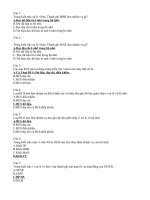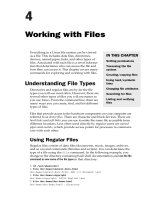M-files
Bạn đang xem bản rút gọn của tài liệu. Xem và tải ngay bản đầy đủ của tài liệu tại đây (76.45 KB, 8 trang )
35
An
if
statement with a two-dimensional matrix
expression
is equivalent to:
if all(all(
expression
))
statement
end
6.7 Infinite loops
With loops, it is possible to execute a command that will
never stop. Typing Ctrl-C stops a runaway display or
computation. Try:
i = 1
while i > 0
i = i + 1
end
then type Ctrl-C to terminate this loop.
7. M-files
MATLAB can execute a sequence of statements stored in
files. These are called M-files because they must have
the file type
.m
as the last part of their filename.
7.1 M-file Editor/Debugger window
Much of your work with MATLAB will be in creating
and refining M-files. M-files are usually created using
your favorite text editor or with MATLAB’s M-file
Editor/Debugger. See also
Help
:
MATLAB
:
Desktop
Tools
and
Development
Environment
:
Editing
and
Debugging
M-Files
.
There are two types of M-files: script files and function
files. In this exercise, you will incrementally develop and
debug a script and then a function for making a matrix
36
diagonally dominant. Create a new M-file, either with the
edit
command, by selecting the
File
►
New
►
M-file
menu item, or by clicking the new-file button:
Type in these lines in the Editor,
f = sum(A, 2) ;
A = A + diag(f) ;
and save the file as
ddom.m
by clicking:
You have just created a MATLAB script file.
1
The
semicolons are there because you normally do not want to
see the results of every line of a script or function.
7.2 Script files
A script file consists of a sequence of normal MATLAB
statements. Typing
ddom
in the Command window
causes the statements in the script file
ddom.m
to be
executed. Variables in a script file refer to variables in
the main workspace, so changing them will change your
workspace variables. Type:
A = rand(3)
ddom
A
1
See or
for the M-files and MEX-files used in
this book.
37
in the Command window. It seems to work; the matrix
A
is now diagonally dominant. If you type this in the
Command window, though,
A = [1 -2 ; -1 1]
ddom
A
then the diagonal of
A
just got worse. What happened?
Click on the Editor window and move the mouse to point
to the variable
f
, anywhere in the script. You will see a
yellow pop-up window with:
f =
-1
0
Oops.
f
is supposed to be a sum of absolute values, so
it cannot be negative. Change the first line of
ddom.m
to:
f = sum(abs(A), 2) ;
save the file, and run it again on the original matrix
A=[1
-2;-1 1]
. This time, instead of typing in the command,
try running the script by clicking:
in the Editor window. This is a shortcut to typing
ddom
in the Command window. The matrix
A
is now
diagonally dominant. Run the script again, though, and
you will see that A is modified even if it is already
diagonally dominant. Fix this by modifying only those
rows that violate diagonal dominance.
38
Set
A
to
[1 -2;-1 1]
by clicking on the command in
the Command History window. Modify
ddom.m
to be:
d = diag(A) ;
a = abs(d) ;
f = sum(abs(A), 2) - a ;
i = find(f >= a) ;
A(i,i) = A(i,i) + diag(f(i)) ;
Save and run the script by clicking:
Run it again; the matrix does not change.
Try it on the matrix
A=[-1 2;1 -1]
. The result is
wrong. To fix it, try another debugging method: setting
breakpoints. A breakpoint causes the script to pause, and
allows you to enter commands in the Command window,
while the script is paused (it acts just like the
keyboard
command).
Click on line 5 and select
Debug
►
Set/Clear
Breakpoint
in the Editor or click:
A red dot appears in a column to the left of line 5. You
can also set and clear breakpoints by clicking on the red
dots or dashes in this column. In the Command window,
type:
clear
A = [-1 2 ; 1 -1]
ddom
39
A green arrow appears at line 5, and the prompt
K>>
appears in the Command window. Execution of the script
has paused, just before line 5 is executed. Look at the
variables
A
and
f
. Since the diagonal is negative, and
f
is
an absolute value, we should subtract
f
from
A
to
preserve the sign. Type the command:
A = A - diag(f)
The matrix is now correct, although this works only if all
of the rows need to be fixed and all diagonal entries are
negative. Stop the script by selecting
Debug
►
Exit
Debug
Mode
or by clicking:
Clear the breakpoint. Replace line 5 with:
s = sign(d(i)) ;
A(i,i) = A(i,i) + diag(s .* f(i)) ;
Type
A=[-1 2;1 -1]
and run the script. The script
seems to work, but it modifies
A
more than is needed. Try
the script on
A=zeros(4)
, and you will see that the
matrix is not modified at all, because
sign(0)
is zero.
Fix the script so that it looks like this:
d = diag(A) ;
a = abs(d) ;
f = sum(abs(A), 2) - a ;
i = find(f >= a) ;
[m n] = size(A) ;
k = i + (i-1)*m ;
tol = 100 * eps ;
s = 2 * (d(i) >= 0) - 1 ;
A(k) = (1+tol) * s .* max(f(i), tol) ;









